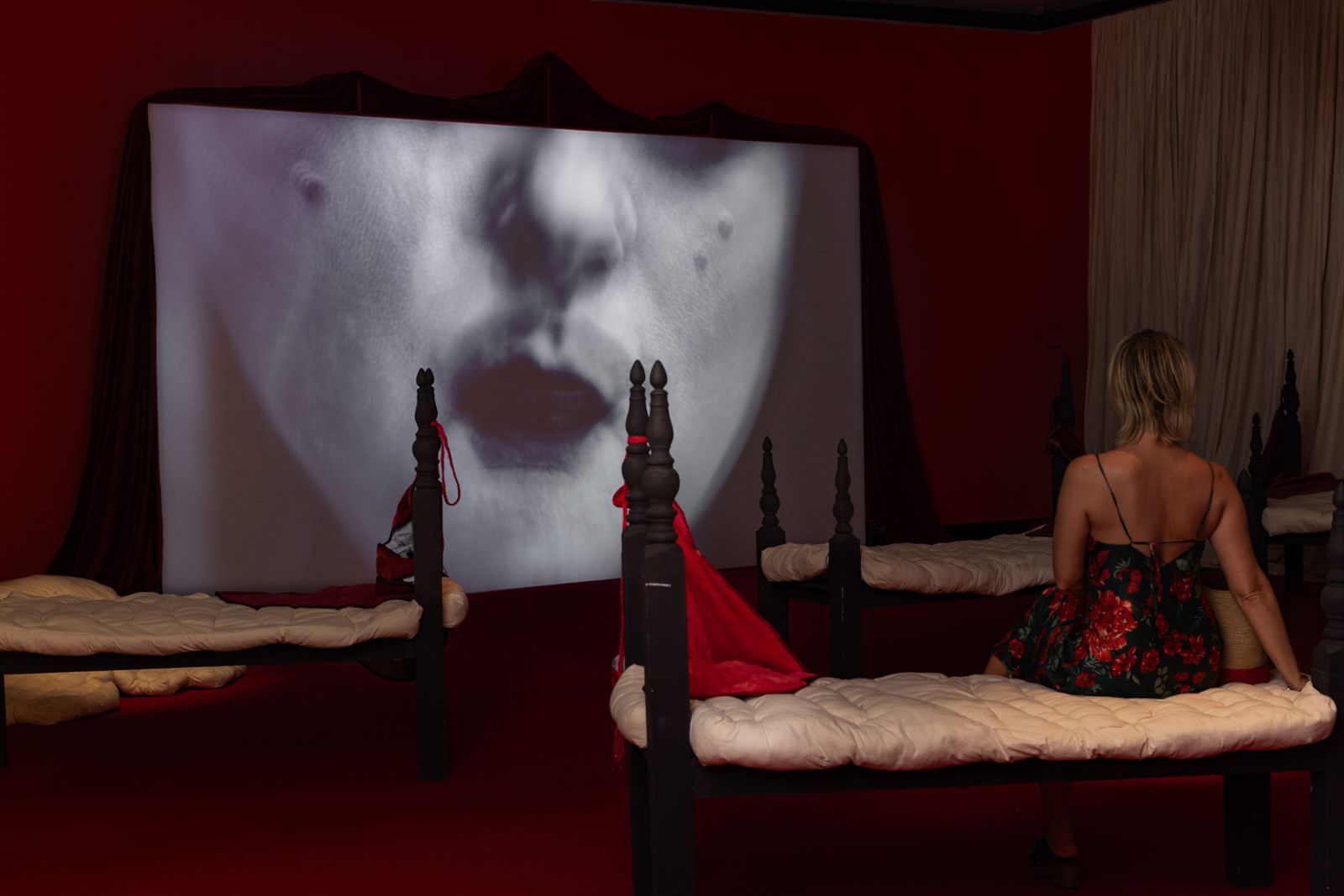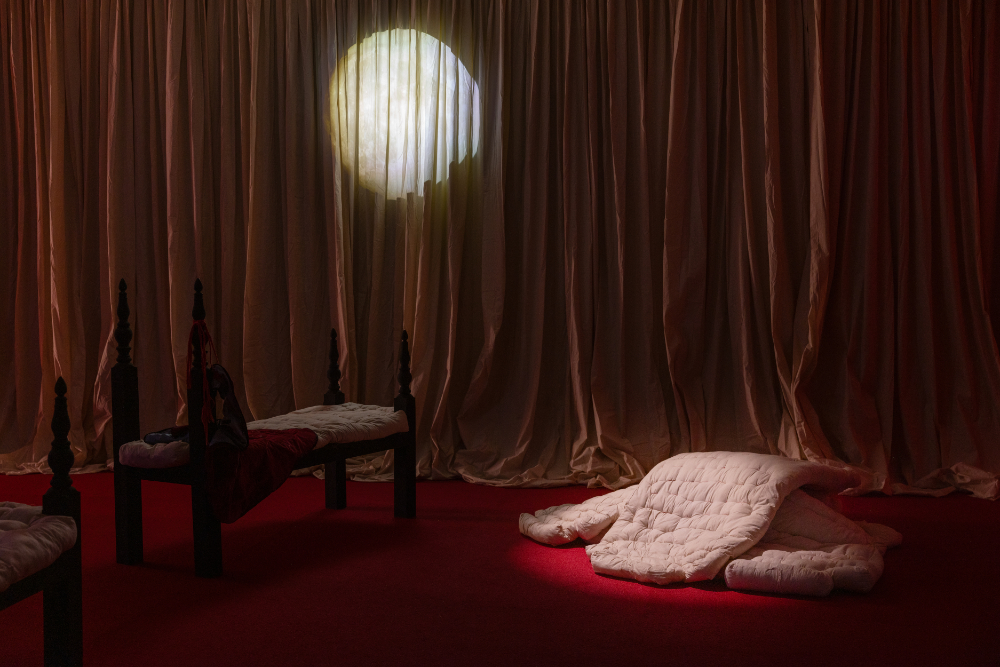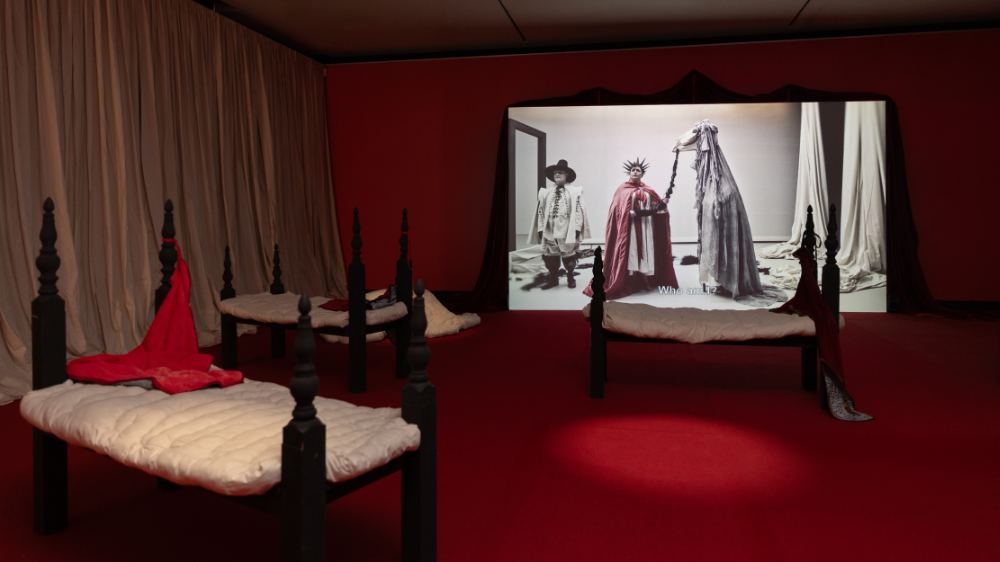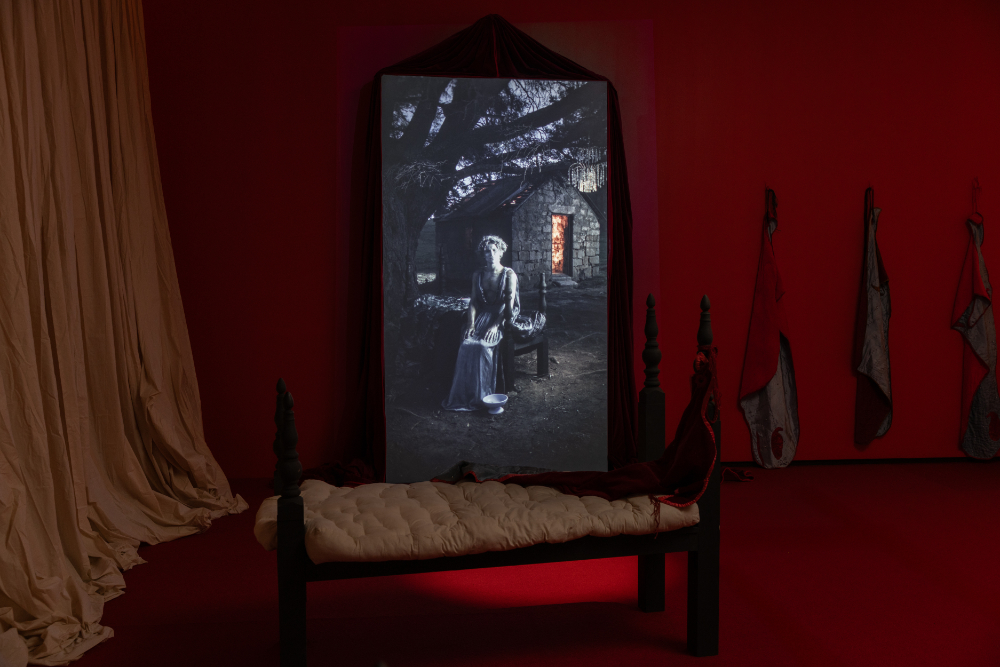
The multiplication of framing devices in Margaret and the Grey Mare is perhaps its first impressive feature. The work is experienced by the audience from within an installation: a kind of dream set campsite composed of small rickety beds and cartoonish lumpy mattresses strewn across the floor and on which the audience is invited to install themselves. The beds have awkwardly made small cloth blankets bound to them more as gestures of childlike comfort-seeking than anything that could ever cover a human body. A full moon is projected on the wall above the facsimile of a large red tent, pressed against the same wall of the gallery, forming a theatre stage. Onto this stage is projected the opera of Margaret and the Grey Mare. Behind the audience a television screen stands facing the stage, a golden figure sits at a mock campfire as though watching the opera with you.
If that wasn’t enough frames, the video itself opens on a wide shot over a theatre, the stage on which the main action of the opera takes place, framed above by theatre lights and below by nearly empty seats. An orchestra tunes its instruments. That’s at least four frames through which the artist Katy B. Plummer has encased her presentation of Margaret and the Grey Mare. It's almost as though she feared the content of her work might escape its cage and seep violently into the world from which its audience was meant to safely contemplate it. Alternatively, this can be seen as an intention to absorb the audience into the work itself, to draw the experience of watching the opera into the reflection that the opera casts onto the world outside of that reflection. A conundrum: what exists outside of that reflection, if the reflection includes what is outside of itself?
The magical ambivalence that permeates the entire work is first established here in the very fact that the artist has settled her audience within the artwork itself. Spread out like so many lost boys on the blankets and beds of an unnamed neverland, we settle into the imaginary of an innocence in which we recognise the echoes of aristocratic gardens where privilege frolics with nature in sentimental pantomime. From here we witness the story of Margaret, which opens on a bed not unlike the ones we sit on, in which Margaret struggles to sleep. The Grey Mare knocks on her door and sings to her that this is the sound of the wind, the sound of her own heart, that she is safe and has nothing to worry about.

From this opening moment, the aesthetic unity of this reflection is rendered as the fantasy that it is. This is established in the very artifice of opera itself, with its exaggerated emotional register, the rendering of speech as song, the gestural and expressive repertoire created to communicate across the distances between the stage and its faraway audience all fix the sense that this is the imaginary. The consummate performance of mezzo-soprano Margaret Plummer is delivered as much in the expression of her face as the tone of her voice: her large eyes, and quivering lip convey an emotion that balances between melodrama and farce, without ever falling into either, that declare the absolute nature of the artifice without actually winking at you, given that you likely have scant knowledge of the artform of opera, allows you to accept its illusion a convention of opera.
This is compounded by the fact that you are in fact watching a film, replete with its own repertoire of artifice: sound, cinematography and editorial synthesis. It's not even a "real" opera, but the artifice of an opera. The exaggerated pantomime of the stage with its classical distances and continuous time are blown out of proportion by the ability of film to collapse time and space, bringing close what is far and intensifying the signifying chains through the montages of sequence onto a scene. The production design, the costumes, the makeup all declare the imaginary nature of what is happening, setting the play in a vaguely European context, vaguely in the era of the reformation or at least at some time in which it would be believable for there to be such a figure as a Witch Hunter. The entire effect coheres in the kind of indeterminacy of a folktale, as something that happens in a world that has fewer details than the one we live in here, now.
Remember that we have left that world: we sit on the facsimile of beds and watch the pantomime play out, the flicker of light casting shadows on a cave wall. At one point Margaret asks the Grey Mare what it is like where she lives. ‘It’s like being on top of the world looking down at all the pretty little things.’ We are sitting in the world of the Grey Mare and despite all the signifiers of its fictive nature, within its spell, it is real. When the Grey Mare says that she is the wind and the rain, she is not telling tales, she is claiming her intangible nature, she is the manifestation of our fear, the possession of loss and guilt, the memory of what is forgotten, she is the ghost of Antigone, and the cause of all of the very real things that men do to each other. You cannot say that she is fake, or that she does not exist. The wind exists.
For this reason, the Witch Hunter seeks the Grey Mare and the Grey Mare troubles Margaret’s sleep. They both seek Margaret’s trust, the one visiting her at night, inviting her to remember a song that has been forgotten, and the other visiting her by day on the pretence of offering work, sewing a garment. The two spiritual forces are joined in the simple gesture of the knock on the door, which beautifully underpins the musical score of the opera as its universal motif. The simple sound of a double knock on wood draws the tension of the drama across the length of the play: stretched between the knocking of the wind and the knocking of the police. Margaret is torn between these two powerful forces, drawn by each into a dangerous complicity. On one side she is seduced by the powers of nature offering an obscure, dangerous freedom and on the other side the Witch Hunter offers her safety (from himself) and a position within the world of men.

It is easy to see this work as a feminist morality play in which the Witch Hunter intimidates and coerces Margaret into denouncing witches and betraying the Grey Mare. This is all true, and in a sense Margaret is a victim in this scenario, but the play insists that her act of surrender is also her act of complicity with the power structure being imposed upon her. She justifies herself, ‘No one can begrudge me a scrap of safety’ as she weaves the bridle that will harness the Grey Mare, who warns that her act will turn Margaret into a cage that she will haunt forever.
The witch is an enlightenment figure, caught between the remnant folk traditions of a spiritualised relationship to nature and the violent severity of the Christian Church as it seeks to consolidate its universal spiritual authority and eradicate its own continuity with “superstition”. This happened at the very moment, in the very movement, that religion produced its own demise in the form of modern science. The persecution of the witch is the spiritual crime through which Western culture attempted (and partly succeeded) in extinguishing its past and detaching itself from its place in pursuit of a universal home that would see it colonise the entire planet.
In a sense, Margaret’s decision is the decision of European culture, to discard the insecurity of a magical relationship to the world for the surety of domination (even as the subject of that domination). This is potentially the parable of Margaret and the Grey Mare, a generalised conclusion that we can draw from the portrayal of a single woman’s struggle with the brutal onset of modernity. While we can read the fate of our entire society in its story, it maintains the emotional access available to us only as we experience our sympathetic association with a particular individual. It is not ironic that it does this through the medium of the Grey Mare itself: the folk tale, the opera, the film, the art installation, these remnant descendants of magical thinking, laid out for us safely in the institutional space of its exhibition.

Like the knocking which binds the Witch Hunter to the Grey Mare, like the frames of the artwork integrating the audience into its fiction, there is a continuity between the two sides of every metaphysic at play in this work that will not allow its moral conflict to settle on one side or the other. The victim is complicit in her surrender, the woman oppressed by patriarchy must make her peace with the victor, and take her place at his side. For the first time in the entire story, at the moment of her surrender, Margaret’s quivering fearful demeanour straightens her back and she lifts her chin. How can you begrudge her a scrap of safety? She did what she had to, she did what we all have to.
The tragedy does not condemn Margaret as a coward or valorise her as a victim but presents the paradox that she is both and that one does not forgive the other. The conflict does not resolve in the result of the battle, but continues in its aftermath, in the howling of her spirit as she survives in the visage of what she hates. This is perhaps most perfectly expressed in the fact that the dialogue of the Grey Mare was generated using AI. How beautiful, how true, that out of the pinnacle of scientific achievement, we have an entity as arbitrary as the reading of entrails, or the throwing of bones to conjure a visage of the other world in which we recognise our fate… Is that not the continuity that the Grey Mare threatens Margaret with?
If we think of the many expanding, mutating, churning moral contradictions we face today, the importance of this work becomes apparent. It is not the job of artists to give us answers but to manifest the questions that we are asking, to manifest the contradictions we are living through in all their painful, confusing opacity. They will do this in forms that are coherent even if incomprehensible, that force us to live with and to face the place we occupy in the world and the world that we face from this place, not so that we can understand it, but so that we can make our play, so that we can act in relationship to it, fail as we must, mistaken as we must be: it is only art that gives us the visage of our condition.
